Charles Brooking is a fascinating and knowledgeable collector of architectural detail, The Brooking Collection of Architectural Detail, and as Surveyors we find his lifelong quest to collect British building details unique, informative and valuable and a collection that must be kept intact for years to come. If you need help and advice with regard to building surveys, structural surveys, structural reports, engineers reports, specific defects report, dilapidations or any other property matters please free phone 0800 298 5424.
The following is one of a series of interviews with Charles Brooking, Historic and Listed Buildings Detail Expert, The Brooking Collection of Architectural Detail and a Surveyor where we have recorded his comments and various aspects that have affected windows and doors and other collectibles. The interviews outline how his collection started and built over the years and gives an insight into the amazing architectural features housed in his fine collection.
Surveyor: What is the 1709 London Building Act?
Charles Brooking : The 1709 London Building Act affected the look of windows with the window frame set back in front of the wall and they were built in, so you had horns and that was much more difficult to remove the windows.
Horns defined
Horns are the bottom most part of the top sliding sash.
Surveyor: So they were set back behind bricks weren't they?
Charles Brooking : Yes, not helpful when on a lunch break with limited time to extract a window!

Surveyor: What is The 1774 London Building Act?
Charles Brooking : The 1774 London Building Act became known as the Black Act with its aim to standardise the quality and construction of buildings making the exterior of a property as fire resistant as possible. With window joinery pushed back into the face of the wall this helped to avoid the spread of fires.

Surveyor: After the 1666 Great Fire of London in 1667 The London Building Act initially required window sills to be compulsory, prior to this window's had either been flush or a small window sill.


We would add that whilst this legislation came into being in 1709 in our experience often it took some time before everyone complied with the legislation and indeed the farther away you travelled from London the less likely the compliance would be carried out with any haste.
The window of this era was either the casement metal window or sliding sash window.
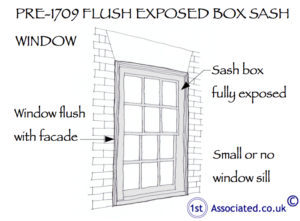
1709 the London Building Act required 100mm (4 inches deep or more) window sill and the setting back of the window. Any older window you see with a window sill of 100mm (4 inches deep or more) is likely to have been built after The Great Fire of London.
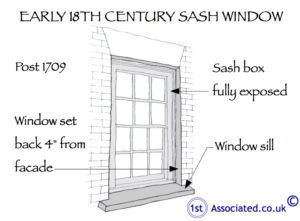
Such was the fear of fire that a second London Building Act was added in 1774 which specifically looked at recessing the timber window frame into the brickwork. This affectively means that part of the window frame is hidden.
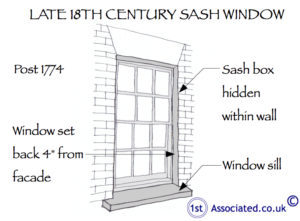
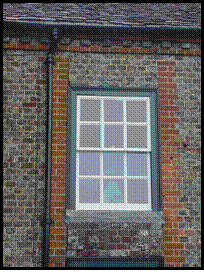
Window with no sill pre 1666
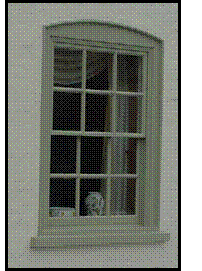
Sliding sash window with sill
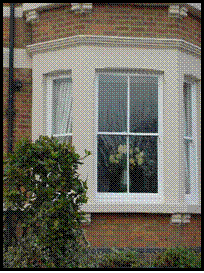
Sliding sash window recessed
into brickwork
A Few thoughts on Sliding sash windows
We have heard that the word window is meant to come from the old English word literally meaning eye hole.
Sliding sash window defined
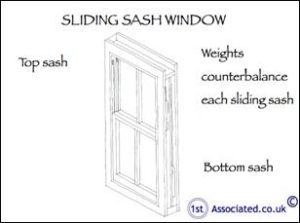
This is two windows known as sashes that overhang each other slightly sliding up and down originally using a set of weights. Sliding sash windows are normally in a vertical manner although they can be horizontal and literally slide sideways (we have heard that these are the older style windows often referred to as York windows or Yorkshire sash windows).
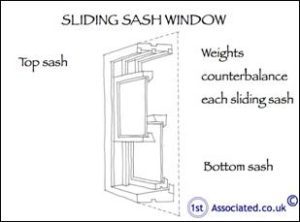
There is much argument with regard to the sliding sash window as to when it was invented and who made them first. Up until fairly recently it was considered that they were invented in the Netherlands in the late 17th century however it is equally argued that the sliding sash window was invented in the early 17th century in central England.
In addition there is the French theory that sliding sash windows came from France as the word sash comes from the French word chassis (meaning frame).
These windows are most popular in the Georgian, Regency, Victorian and Edwardian eras.
If you found this article on The Brooking Collection of Architectural Detail interesting you may also be interested in the following articles on our 1stAssociated.co.uk website:
Donations from St Paul's Cathedral
Houndsditch, moving a window is easier said than done!
Listed Buildings and Character Properties
From Fire Marks to John Braid Wood, the Surveyor who set up the Fire Brigade
References:
TheBrookingCollection.com
DartfordArchive.org.uk
IHBC.org.uk
ProjectBook.co.uk
Independent Surveyors
If you truly do want an independent expert opinion from a surveyor with regard to building surveys, structural surveys, structural reports, engineers reports, specific defects report, dilapidations or any other property matters please contact 0800 298 5424 for a surveyor to give you a call back.
Commercial Property Surveyors
If you have a commercial property, be it leasehold or freehold, then you may wish to look at our Dilapidations Website at www.DilapsHelp.com and for Disputes go to our Disputes Help site www.DisputesHelp.com.
We hope you found the article of use and if you have any experiences that you feel should be added to this article that would benefit others, or you feel that some of the information that we have put is wrong then please do not hesitate to contact us (we are only human).
The contents of the website are for general information only and is not intended to be relied upon for specific or general decisions. Appropriate independent professional advice should be paid for before making such a decision.
All rights are reserved the contents of the web site is not to be reproduced or transmitted in any form in whole or part without the express written permission of 1stassociated.com.co.uk

